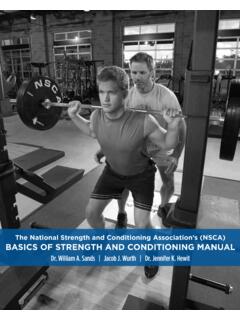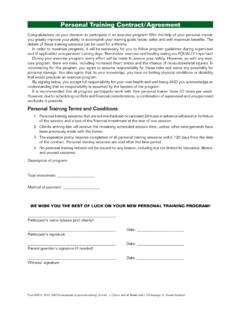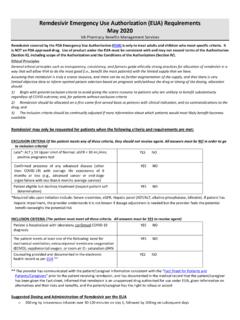Transcription of FOUNDATIONS OF FITNESS PROGRAMMING - NSCA
1 FOUNDATIONS OF. FITNESS PROGRAMMING . NATIONAL STRENGTH AND. CONDITIONING ASSOCIATION (NSCA). FOUNDATIONS OF. FITNESS PROGRAMMING . DEVELOPMENT TASK FORCE MEMBERS. Nick Clayton, Joe Drake, Scott Larkin, Robert Linkul, Mike Martino, Mark Nutting, and Nick Tumminello Copyright 2015 National Strength and Conditioning Association. All Rights Reserved. TABLE OF CONTENTS. FOUNDATIONS OF FITNESS PROGRAMMING OVERVIEW 5. About 5. Why was the FFP developed? 5. Designing Individualized FITNESS Programs 6. 1. Consultation and Discussion of Goals 6. 2. Evaluate Health History Forms and Perform a FITNESS Assessment 6. 3. Establish Goals 6. a. Agree Upon the Goals 7. b. Define Roles and Responsibilities 7. c. Identify and Address Roadblocks 7. 4. Develop the Training Program 7. IMPLEMENTING THE FOUNDATIONS OF FITNESS PROGRAMMING 8. FOUNDATIONS OF FITNESS PROGRAMMING : INSTRUCTIONS AND APPLICATION 9. MOBILITY, MOVEMENT PREPARATION, AND FLEXIBILITY TRAINING 10.
2 Warm-Up Benefits 10. Dynamic Warm-Up Recommendations 11. Dynamic Warm-Up PROGRAMMING Considerations and Recommendations 11. Flexibility Training 11. PROGRAM DESIGN: BASICS 12. Classifying Training Status and Training Frequency Recommendations 12. Sequencing of Training 13. Exercise Selection, Regression, and Progression 13. Training Variables 14. Assigning Load 14. Program Design Methods and Descriptions 15. PROGRAM DESIGN: PHASES OF TRAINING 16. Muscular Endurance 16. Sequencing Example for Muscular Endurance Goal 17. Hypertrophy 17. Sequencing Example for Hypertrophy Goal 18. Muscular Strength 18. FOUNDATIONS OF FITNESS PROGRAMMING | Copyright 2015 National Strength and Conditioning Association. All Rights Reserved. TABLE OF CONTENTS. Sequencing Example for Muscular Strength Goal 19. Muscular Power 19. Sequencing Example for Muscular Power Goal 19. NUTRITION AND PERSONAL TRAINING 20.
3 Scope of Practice 20. Practical Recommendations for Weight Loss 21. Practical Tips for Weight Gain 21. Common Myth: Bulking and the Pump 21. Constant State of Flux 21. CARDIOVASCULAR TRAINING 22. Specificity of Aerobic Endurance Training 22. Training Frequency and Duration 22. Progression 23. Cardiovascular Training Types and Exercise Intensity 23. Resistance Training's Effect on Endurance Performance 23. Resistance Training and Endurance Performance Key Points 23. CORE TRAINING 24. Defining the Core 24. Core Connections 25. Multi-Joint Exercises and Core Activation 25. Core Training and Progression 25. APPENDIX 27. Appendix A. Initial Consultation Sample Questions/Considerations 28. Appendix B. Dynamic Warm-Up Exercise List 29. Appendix C. Primary Movement Patterns and Exercises 30. Appendix D. Core Training Exercises 31. REFERENCES 32. FOUNDATIONS OF FITNESS PROGRAMMING | Copyright 2015 National Strength and Conditioning Association.
4 All Rights Reserved. FOUNDATIONS OF ABOUT. The FOUNDATIONS of FITNESS PROGRAMMING (FFP) was written FITNESS PROGRAMMING . to highlight the essential, research-based components of designing FITNESS programs, and to bridge the gap by providing recommendations to apply research to practice. It is not meant to OVERVIEW replace individualized training, nor is it a cookie-cutter, one-size-fits- all program. It is meant to serve as a resource and educational tool for personal trainers to design training programs quickly and effectively, which are progressive in nature and specific to the needs and goals of their clients. The FFP provides supporting rationale and scientific references for the recommendations made, and these references can be found in the appendix. Practical training tips and links to relevant journal articles and exercise technique videos have also been added. There are corresponding spreadsheet templates formatted to provide periodized training programs that include drop-down menus for exercise selection, pre-programmed exercise variables that correspond to the phases of training, and recommendations for aspects of a personal training session including dynamic warm-up, resistance, cardiovascular, and flexibility training.
5 WHY WAS THE FFP DEVELOPED? As the worldwide authority on strength and conditioning, the National Strength and Conditioning Association (NSCA) supports and disseminates research-based knowledge and its practical application to improve performance and FITNESS . Since the practical application often provides the greatest challenge to novice personal trainers, the FFP was developed to bridge that gap, helping personal trainers FOUNDATIONS OF FITNESS PROGRAMMING | Copyright 2015 National Strength and Conditioning Association. All Rights Reserved. 6. efficiently and effectively design training programs based on assessment, and then updated every 4 6 weeks of training. scientific principles, specific to the individual needs of their clients. The following steps identify a systematic process used to develop the training program: Personal training is often referred to as an art form ( , the art of applying research-based knowledge to individual situations 1.)
6 Consultation and Discussion of Goals including, but not limited to, a client's goals, current/previous The initial consultation is an opportunity for the personal injuries, health and FITNESS status, level of physical competency, trainer to establish professional credibility, determine self-efficacy, self-confidence, etc.). While there are general training client-trainer compatibility, and develop rapport and trust principles that apply to everyone, there are a number of factors with the client. A personal trainer establishes credibility that affect program design and client motivation. Regardless, by debunking FITNESS myths and explaining the scientific programs should adhere to the principles put forth by the NSCA. rationale and PROGRAMMING necessary to reach their goals. These principles (Haff G. H., 2012) are: Rapport and trust are developed when the personal trainer asks the right questions and demonstrates active listening 1.
7 Specificity (individuality) to the client's responses; thereby, increasing the likelihood Designing training programs/workouts with a specific goal that a client will discuss the underlying motivational factors in mind based on each client's individual needs. Specificity driving them to achieve their goals. These factors lay the in training can be accomplished by targeting muscle foundation for open communication between the personal groups, energy systems, speed of movement, movement trainer and client, and increase the likelihood that their patterns, and/or muscle action types (Haff G. H., 2012). goals will be attained. 2. Overload During the initial consultation, personal trainers should The training stress (based on frequency, intensity, and type ask questions pertaining to training history, resources, and of exercise as well as recovery processes) placed on a client other obstacles ( , time constraints, equipment access, should exceed the training stress experienced during the family commitments etc.)
8 , as well as begin the initial previous workout. This is accomplished by increasing the discussion of training goals. This information provides the load, sets, reps, or by decreasing the rest periods. road map to designing effective programs; it tells the trainer where the client wants to go and identifies where 3. Progression they are starting from. It is important to note that goals Similar to overload, progression (or progressive overload). should be discussed in general terms during this initial refers to the systematic modification of a training program consultation. goals (see below) can only be over time. In addition to exercise intensity, progression accurately set following the evaluation of health history and also refers to frequency and increasing the difficulty of FITNESS assessment. exercise selection (advancement from low-skill to high-skill exercises). Exercises are progressed on an individual basis Refer to Appendix A for sample questions to ask during the rather than a pre-determined schedule, based on a client's initial consultation.
9 Ability and speed of adaptation. 2. Evaluate Health History Forms and Perform a FITNESS 4. Variation Assessment Variation is considered planned variety in exercise selection The results of the health history forms and FITNESS and training variables. assessments are used to design a client's individual training program. This data includes a baseline for Keeping in line with these principles, the FFP provides a future comparison, identification of current FITNESS level, recommended (linear periodization) training sequence that clarification of goal setting, and assistance in prescribing consists of muscular endurance, hypertrophy, strength, and initial exercise frequency, volume, and intensity. power phases for relatively untrained through advanced clients. While other periodization models exist, a linear model is 3. Establish Goals suggested for beginners. Successful programs train clients at a level that matches their needs and abilities to meet their specific goals.
10 DESIGNING INDIVIDUALIZED FITNESS PROGRAMS. Following the initial consultation, health history evaluation, A training program should be based on the individual needs and FITNESS assessment, the personal trainer and the client and abilities of a client in order to maximize the effectiveness should work together to develop specific, measurable, and efficacy of the training program as well as decrease the action-oriented, realistic, and timely ( ) goals. Tips risk of injury or overtraining. These needs and abilities should for effectively establishing goals include: be determined during the initial consultation and FITNESS FOUNDATIONS OF FITNESS PROGRAMMING | Copyright 2015 National Strength and Conditioning Association. All Rights Reserved. 7. a. Agree Upon the Goals The personal trainer and client should develop and agree upon the goals together. The client provides the why ( , their motivation for achieving these goals), while the personal trainer determines whether the goals are realistic, including time frame to achieve goals, and develops and explains the overall plan for achieving those goals.
















